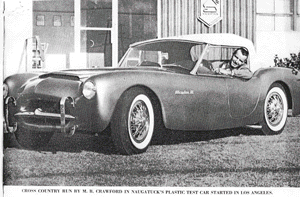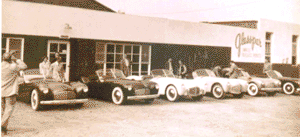| Cars – Home | |||
| Glasspar – Home | |||
| History | Brochures & Advertising | Models Available | Bibliography |
| Showcase | Discussion Group | Miscellaneous | Contact / Registry |
Prologue
This is the first complete and accurate history of the Glasspar G2. There have been many accounts of Bill Tritt and this unique car, but most cover just a part of his far-reaching influence and of the car’s impact on the automotive world. Those short but brilliant seven years in the early ’50s when the Glasspar G2 was being produced were a turning point in not only the auto world but in other industries in the use of fiberglass in construction. The Glasspar G2 was the world’s first production fiberglass-bodied car; this account traces its evolution.
The History
The Glasspar G2 was born in 1949 when Air Force Major Ken Brooks showed Bill Tritt the hot rod he was building, which consisted of a stripped-down Willys Jeep with a highly modified V-8 engine. Bill, at the time, was building small fiberglass boats in his Costa Mesa, California, factory, and he convinced Ken that fiberglass was the best material to use for the hot rod’s body.
Bill made sketches of a body and, with Ken’s and his wife’s approval, proceeded to make the body plug and mold for a low-slung, continental-style roadster. It was a good year and a half, with lots of trial and error, until the body was finished, set on the chassis and christened the Brooks Boxer in mid 1951.
Bill Tritt was born in 1917 and had an abiding interest in boats and cars. Before the war, he studied marine architecture and boat building. He worked for Douglas Aircraft’s Production Planning and Illustration Departments during WW II, and by 1945 had built a number of catamaran sailboats. In 1947, John Green, a yachtsman friend, commissioned Tritt to design and build a high-performance sailboat in the 20-ft. range. Fiberglass seemed the logical construction material, and Otto Bayer of Wizard Boats was enlisted as laminator. The boat was named the Green Dolphin, and four were built. This was Tritt’s introduction to fiberglass-reinforced plastic (FRP). By 1947 he was building small fiberglass boats, and built the first ever fiberglass masts and spars for sailboats.
This company became the Glasspar Company and moved to larger quarters in Santa Ana, California, in the early 1950s. By the mid 1950s, Glasspar was producing 15 to 20 percent of all fiberglass boats sold in the U.S.
The Brooks Boxer was an immediate success when shown at the 1951 Los Angeles Motorama along with three other early fiberglass cars: the big Lancer, the small Skorpion and the Wasp. Only Tritt’s car went on to be the first production fiberglass car. The Boxer mold was used to produce the beautiful Glasspar G2 sports car that year.
The Korean War was going on, and Tritt was having trouble getting polyester resin for his cars and boats. The Naugatuck Chemical Company, after seeing the Boxer, sent Glasspar plenty of Vibrin resin and an order for a G2 sports car to promote their product to the auto industry. Naugatuck’s G2 was named the Alembic I and was shown at the Philadelphia Plastics Exhibit in 1952. Life Magazine then did a feature story on the car, as did the New York Times, the Wall Street Journal and just about every auto trade magazine. The Glasspar Company then went public and sold stock to raise capital.

The Alembic I in Philadelphia
After Naugatuck’s Alembic was shown in Philadelphia in 1952, the car was presented to Harley Earl, the Chief Stylist of General Motors, in March of that year. The car was borrowed by General Motors for a month of evaluation, and Chevrolet then designed and built the fiberglass Corvette. Bill Tritt’s friend, Brandt Goldsworthy, was a consultant to them on their fiberglass problems and techniques.
The Corvette fiberglass bodies were fabricated using the faster but less rigid pressure-molded process rather than the superior and stronger hand-laminated process used at Glasspar for all their car bodies. This accounts for the fact that the Glasspar bodies are as sound today as they were when they were built.
Naugatuck drove the Alembics over 2,000 miles for show, and to prove their durability. The Alembic II was a Chocolate Brown Series II Woodill Wildfire, also driven crosscountry.

The Alembic II


The Glasspar G2 sports roadster has a 101-in. wheelbase and a standard 55-in. to 59-in. tread using 600 x 16 tires. With the engine set back behind the front axle, the car has a perfect 50-50 weight distribution on the wheels, and with the light weight and wide tread, the handling characteristics are superior. The factory Glasspars came with interiors and engines to the customer’s choice with the suspension preferably Ford.
Glasspar designed a new stiff 2″ x 3″ tubular frame for the G2 body which took ’39 to ’48 Ford running gear and almost any engine. Of particular note was the racing Mameco Glasspar with its 230-hp, 284-cu.in. C.T. Ardun Mercury engine. With this powerful engine and new frame, the car was a sensation on the track in speed and handling, passing most cars at will. The car weighed only 1,900 lbs.

Bill Tritt in the Ardun-Merc Glasspar G2

The Glasspar 2″ x 3″ Tubular Frame
This frame was fabricated by Mameco and was used by Glasspar for their factory cars and kits. Woodill also used this frame for their Series II Wildfires.
Glasspar made about 10 production cars at the Santa Ana factory, some for famous persons such as Gary Cooper and Rosemary Clooney. A factory car sold for $2,950; the rest were sold as kits, with the cost of the 185-lb., 3/16″-thick body with molded cockpit and trunk, $650, the frame, $200. There were many extras provided by Glasspar, such as a molded dashboard for $18 and a second door for $75. Additionally, you could get a fiberglass hardtop, bucket seats, hood air scoop and wind wings. The body always included aluminum posts for the two-piece windshield. Almost any engine could be mounted in the G2 – Cadillac, Buick, Chrysler, Lincoln, etc., with the most popular being the Ford flathead.

Glasspar – Santa Ana, California
Bill Tritt produced the G2 and other car bodies, starting from the Boxer in 1951 until the end of production in 1955, producing well over 200 – about 100 G2’s, 100 Wildfires, 10 racecar bodies for Frank Kurtis, and a number of other interesting cars. The Glasspar was also listed in the Standard Catalog of American Cars, ’46-’75.

Bill Tritt is the “father of the fiberglass car” and his G2, the forerunner of all production fiberglass cars. On 2 June, 2000, a brilliant red Glasspar G2 was placed on the exhibition floor of the Smithsonian’s National Museum of American History in Washington, DC, as an American original, alongside other unique cars that have made history. Dale Dutton graciously donated his car so it would be enshrined properly among the world’s best.
Designer and builder Bill Tritt was there to receive his and the Glasspar G2’s honors.

Bill Tritt and the Smithsonian Glasspar G2
Later that same day, most of the Smithsonian well wishers traveled to Glasspar G2 owner Bill Hoover’s home to drive his car. This was a historic moment for all, especially Tritt, driving a car he had produced some 48 years before.

Bill Tritt Driving the G2
There were other notables at this historic occasion, and they gathered around the car for the group picture that truly shows the timeless beauty and style of the Glasspar G2, the world’s first production fiberglass car.

Carolyn and Bill Hoover – Glasspar Owners
Bill Tritt with son Greg and friend Carol
Dale Dutton – Donor of the Smithsonian Glasspar
Jean and Joy Porier – G2 Owners and First G2 Registrar
Shelly and Harold Pace – Auto Historian and Writer

This site is protected by reCAPTCHA and the Google Privacy Policy and Terms of Service apply.